You’ve perfected your business-to-consumer (B2C) sales process. Selling to businesses is a whole ’nother ball game.
Business buyers have wildly different expectations, demands, and pain points from generic consumers. The messaging you’re using needs to reflect this—as does the sales process you’re using to convert B2B leads into high-value customers. Part of this means shifting online.
Ecommerce is dominating the business-to-business sales market. By 2025, 80% of B2B commerce is expected to take place online. This guide shares how to position your B2B business in the best light, attract customers to your B2B storefront, and convert them—all without having a sales representative heavily involved in the process.
What is B2B sales?
B2B sales is the process of selling products to another business. The sales cycle for these transactions is of higher value and takes much longer to finalize than business-to-consumer (B2C) sales.
Popular examples of B2B ecommerce include:
-
A manufacturer selling product parts to another business
-
A retailer selling its products to a wholesaler, which adds its own markup before reselling products to its own customers
-
A business purchasing products from other businesses for internal use, such as office chairs or accounting software
What does the B2B sales process look like?
The B2B sales process differs from B2C, where a single consumer decides to make a low-value purchase from an online store.
Gartner outlined a typical B2B sales funnel using the jobs-to-be-done framework:
-
Problem identification. “We need to do something.”
-
Solution exploration. “What’s out there to solve our problem?”
-
Requirements building. “What exactly do we need the purchase to do?”
-
Supplier selection. “Does this do what we want it to do?”
-
Validation. “We think we know the right answer, but we need to be sure.”
-
Consensus creation. “We need to get everyone on board.”
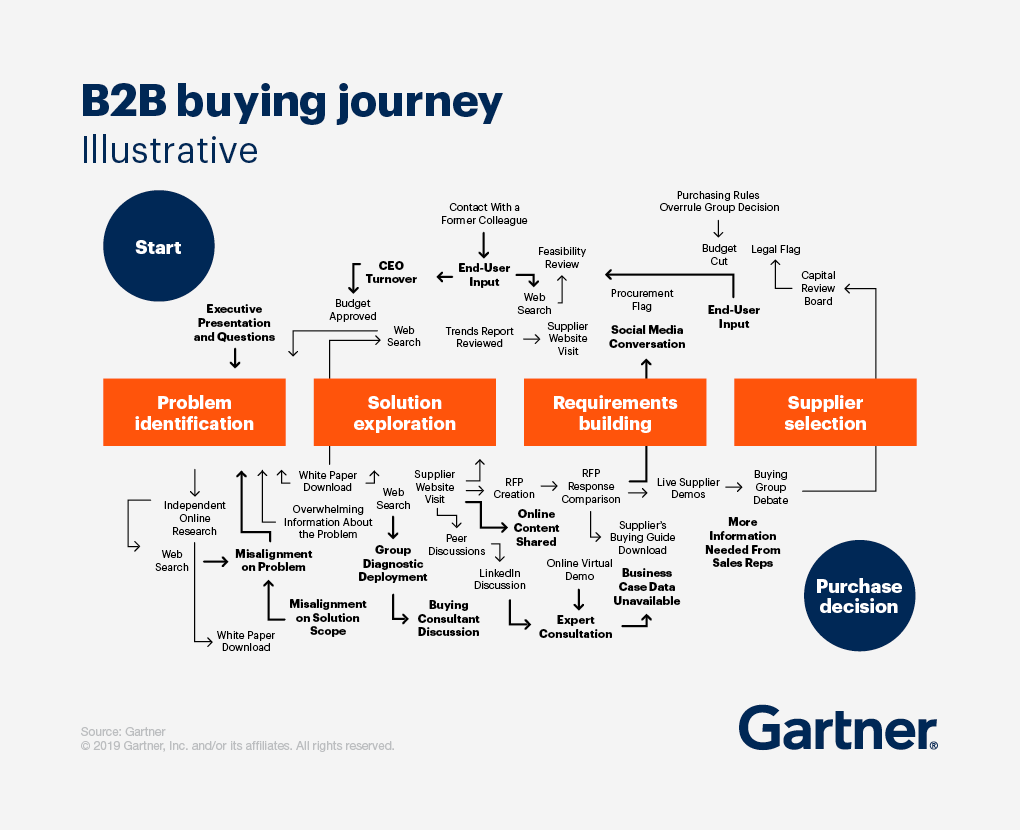
Alongside these different jobs your B2B customers are aiming to solve, key differences between B2C and B2C sales processes include:
-
More people are involved in B2B purchase decisions. From identifying a problem to comparing solutions, the average B2B decision-making process involves between six and 10 people. If you’re selling to wholesale customers, for example, that might be the retailer’s founder, merchandising manager, accounting executive, and store manager.
-
Longer sales cycles. More than a quarter of B2B sales cycles span four to six months. It’s a figure set to balloon even further—21% say their B2B purchase timeline has increased significantly over the past year.
-
Business buyers demand deep industry knowledge. There’s more risk associated with spending business dollars (as opposed to a consumer’s disposable income). Brands need to know they’ll make a return on their investment. Your B2B sales team needs intimate knowledge of the product and industry you’re operating in when communicating with potential buyers.
The typical B2B sale cycle is considerably longer than a B2C sale. This is because businesses are slower to make decisions than consumers. In most cases, several decision makers are involved in the B2B buying process, each of whom may have different priorities and concerns. For an ecommerce business selling B2B, this means that it can take weeks or even months to close a deal.”
—Brandon Chopp, digital manager for iHeartRaves
“Converting a business sale is very different than the average consumer sale,” says John Helwig, founder of Fresh Roasted Coffee. “There’s far less browsing and comparison. Our B2B customers know what they want, know the price they’re willing to pay, and want the entire process to be as quick and easy as possible.
“[It] allows us to provide them a portal that’s a stripped down version of our consumer site—one that focuses on their needs and shows them their pricing immediately. They’re able to put together an order in just a few seconds, which allows us to get their coffee in our roasters and out to them—often in less than 24 hours.”
B2B sales strategies and frameworks
-
Go omnichannel
-
Prioritize self-serve ecommerce sales
-
Employ a B2B sales team
-
Personalize your sales approach
-
Integrate with B2B marketplaces
-
Offer flexible B2B payment terms
-
Enable mobile ordering
-
Offer low first-order minimums
-
Build an online portal to make reordering simple
-
Automate the B2B sales process
1. Go omnichannel
B2B buyers aren’t always middle-aged people sitting in a boardroom wearing suits and exclusively buying from trade shows. Almost 73% of millennials, a generation that grew up around the tech boom of the 2000s, are now involved in the B2B buying process. And they want the same shopping experiences they receive when buying products for themselves.
An omnichannel approach to B2B sales helps deliver on those expectations. You’ll make your products more accessible to millennials, and be in their eyeline during their daily routines, by offering sales support at each touchpoint they’re already using.
“Know how, why, and at what speed your customers buy. Understand that there are many sales you aren’t making because your ecommerce strategy needs to deliver an excellent experience regardless of the channel being used.”
— Louis Columbus, Director at Global Cloud Product Management & Enterprise Software Strategist at Forbes
So, what are those B2B sales channels? According to McKinsey, two-thirds of B2B buyers prefer remote human interactions or digital self-serve through channels like social media and ecommerce. The top-producing revenue channels for B2B companies are ecommerce and in-person, tied at 18% respectively. That’s followed by email, online chat, video conferencing, and traditional phone calls.
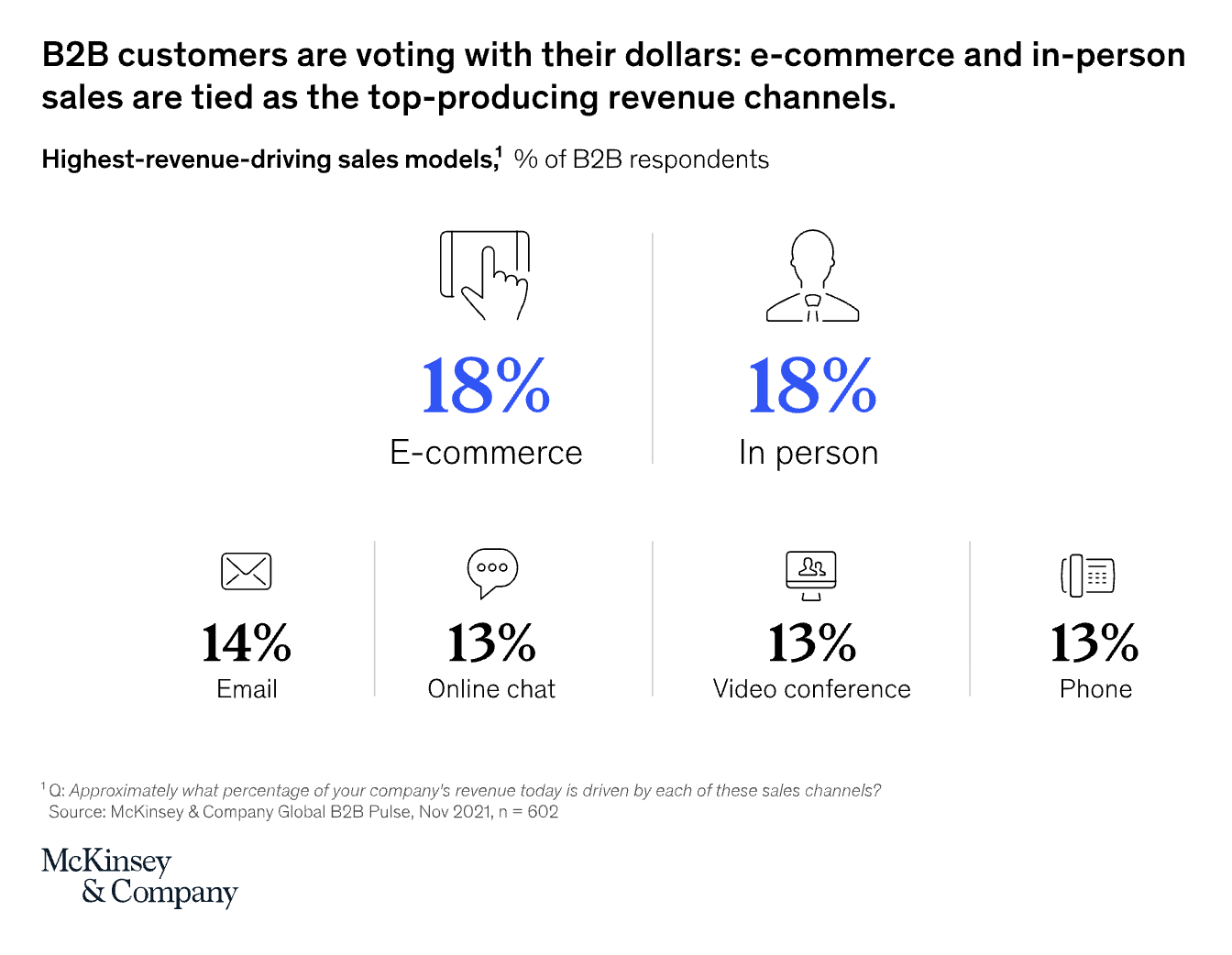
Regardless of who you’re selling to, don’t be afraid to switch between multiple channels. Proactively reach out to potential customers when you spot them lingering in certain touchpoints.
If you use B2B sales tools like Leadfeeder to discover the B2B customers visiting your website, you might notice a potential buyer you saw at a trade show recently browsing the product page of a SKU they viewed in person. Reach out to them through email or live chat to nudge them further along the sales process.
It’s why 83% of B2B leaders believe this type of omnichannel selling is a more successful way to prospect and secure B2B sales than face-to-face-only sales approaches.
2. Prioritize self-serve ecommerce sales
Omnichannel reaches B2B customers wherever they’re browsing. Some 80% of B2B brands are prioritizing making their online channels as good or better than offline ones—and for good reason.
Studies show that more than one-third of B2B buyers are willing to spend more than $500,000 in a single transaction on digital channels. For 15% of decision makers, that comfortable purchasing figure tips more than $1 million.
Still not convinced? Consider this data:
-
18% of the average B2B company’s revenue comes from ecommerce.
-
83% of B2B buyers prefer ordering or paying through digital commerce.
-
Only 24% of B2B buyers in primarily sales rep-led purchases completed a high-quality deal, versus 65% of B2B buyers who navigated the process themselves.
Take it from Michael Martocci, founder of SwagUp, who says, “We now have customers willing to place $50,000+ orders online on their own with minimal to no hand holding by reps. If you can get large B2B AOVs with low sales overhead, you can build a pretty profitable business.
“Consumers are much more frictionless and the B2B companies that will win going forward are the ones that take archaic transactions and bring them online and make them simple.”
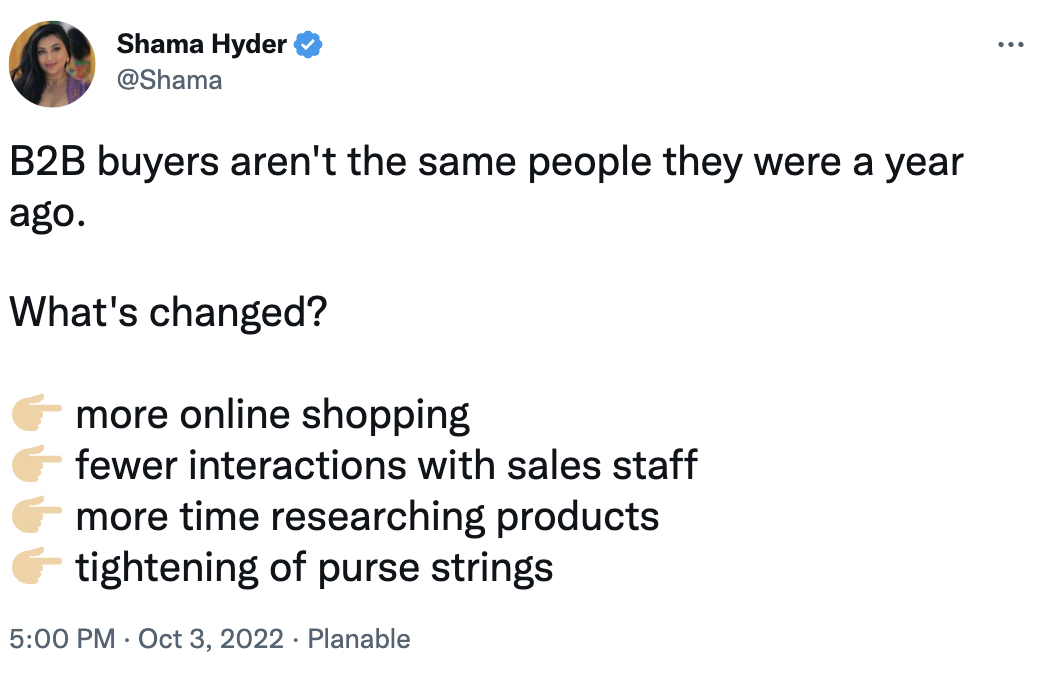
Cater to business customers who prefer self-serve with a B2B storefront alongside your main DTC website. With Shopify, you can run both sides of your business, leveraging the same product catalog and DTC features from a single back end. The only difference is B2B buyers log in to their company profile to view wholesale pricing, discounts, and streamlined B2B checkout.
We use Shopify to create custom orders as it allows us to invoice the customer with a direct link to Shopify checkout. It also allows our international customers to pay via card payments, which is quicker and easier than international BACS payments.”
—Sophie Gibson, PR and communications assistant at S’wheat
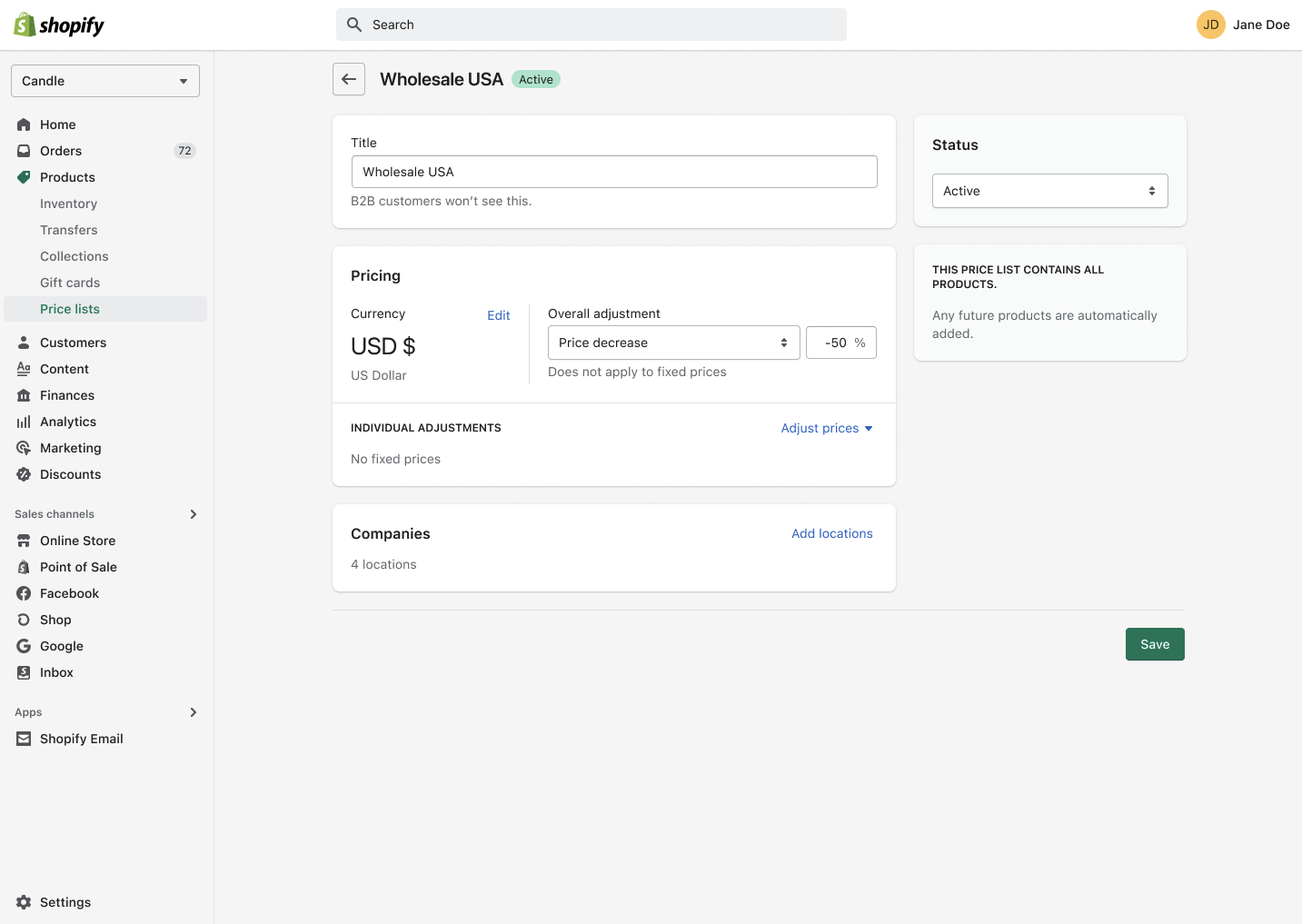
3. Employ a B2B sales team for extra support
An increasing number of buyers are making business purchases unassisted through a retailer’s wholesale storefront. That’s not to say they’re forgoing sales and support reps entirely.
It’s why Meredith Erin, CEO of Boredwalk, says, “If a brand is serious about growing B2B, you really need to either work with a rep group or hire an in-house sales team.
“There’s a lot of relationship building involved and it’s a very different model than DTC. Hiring a sales staff with connections and experience in your product vertical is probably the fastest way to start to scale a B2B business.”
Employ a team of B2B salespeople to guide customers through the purchasing journey, should they require help. That could mean:
-
Generating qualified leads via cold prospecting or outreach
-
Attending in-person events, such as trade shows, to be the face of your brand
-
Following an account-based sales strategy that connects with buyers on a personal level
-
Reconnecting with leads that haven’t contacted you in a while and informing them of new stock that’s selling well for other retailers
Squishface is a pet care business that puts this B2B sales strategy into practice. Its online sales manager, Kami Myers, says, “Our strategy is to offer a very hands-on and personalized experience for each of our B2B customers, as we aim to create long-term partnerships with our vendors. Each one has a designated Squishface representative that walks them through the ordering process and customizes the process to their needs.”
“Until now, we’ve just been focused on closing inbound deals, but we want to hire for more specified roles that allow us to pitch new businesses.”
—David Schneidman, director at Alvarez & Marsal Consumer Retail Group (via Modern Retail)
This approach doesn’t just apply to new B2B customers. One key advantage of B2B ecommerce is that customer loyalty is baked in. If the relationship with your customers is strong, they’ll continue to purchase from your brand for years to come.
Have your sales reps engage with existing B2B customers to squeeze more lifetime revenue out of each one. Whether they’re giving advice on how to resell your products or notifying them of changing consumer trends, strong relationships require two people to be involved. That’s not always possible by offering self-serve B2B sales in silo.
“To get loyal B2B ecommerce customers, you need to provide a high level of customer service.”
—Sang Huynh, CEO of Elbilgrossisten AS
4. Personalize your sales approach
The motivation behind a business purchase varies dramatically from B2C. Michael Martocci, founder of SwagUp, says, “B2B buyers are spending company funds, maybe doing it to save time, to look good in front of their team, or to solve some core business challenge.
“They may need to get buy-in from other stakeholders and may not be the person actually getting value out of the solution, so you may need to equip or educate them on why what you are selling matters and is the right solution.”
Success in B2B selling relies on your B2B sales team’s ability to identify and resolve a buyer’s pain point—using your products as part of the solution. It’s why 30% of B2B decision makers say speaking to a buyer’s pain points is the most important factor in their sales strategy.
The benefits of creating content for each stage of the buyer’s journey are shorter sales cycles, higher conversion rates, and increases in our marketing-sourced pipeline and revenue.”
—Amy Barzdukas, CMO of WiTricity
To uncover your B2B customers’ pain points, survey previous buyers. What was the trigger that caused them to start looking for your products? What problem were they trying to solve when making their first purchase?
Position future communications around these pain points. If you’re selling to a retailer that’s struggling to build hype around its store, for example, email them case studies of how similar brands have stocked your products, ran a co-marketing campaign, and increased footfall. It’ll coax potential customers into calculating a positive ROI on their purchase, making it a no-brainer for them to convert.
“Marketers like to believe that B2B organizations don’t need or desire a personalized shopping experience,” says Shayla Price, B2B content and email marketer. “This myth limits our thinking, and ultimately we miss the opportunity to earn more sales.
“To personalize the B2B experience, focus on satisfying the needs of multiple stakeholders within the company. You can accomplish this task by creating worthwhile content that addresses their individual concerns. That way, the entire team sees your product as their solution.”
Gartner predicts that when this B2B sales approach is done right, it can improve buyer decision making quality by 11%—resulting in happier customers and, ultimately, more revenue for your business.
B2B sales trends in ecommerce shows that people want quick, convenient, and simple services done perfectly. Be honest and clear. If something isn't working, say so. Find out how you can help the partner profit, not just yourself.”
—Briannah Klais, public relations coordinator at Tad More Tailoring
5. Integrate with B2B marketplaces
Earlier, we mentioned how B2B buyers prefer omnichannel sales. The easier it is for them to purchase through channels they’re familiar with, the higher the chance of your B2B sales team converting them.
One of those touchpoints includes wholesale marketplaces. Research suggests 60% of B2B buyers would be open to purchasing on a digital marketplace—the same figure as those who’d buy from supplier-branded online stores.
Popular B2B marketplaces to integrate as part of your ecommerce sales strategy include:
Marketplaces connect B2B customers with businesses and charge a fee for each transaction that happens through each platform. You’re also at the mercy of the marketplace’s rules, limiting the experiences you give to customers.
Diversify the online channels you’re using to mitigate this issue. Prioritize B2B sales through your own ecommerce website to deliver DTC-style experiences your business customers ask for.
6. Offer flexible payment terms
The purchase process for B2B customers differs from B2C—the latter of which forces customers to pay for their purchase at the time of ordering. Businesses, however, expect flexible payment terms. This is typically net 30, 45, or 60 days after ordering, which gives B2B customers plenty of time to resell your products and generate a profit.
Remove this pre-purchase friction by offering flexible payment terms. Use Shopify’s B2B customer portal functionality to:
-
Allow B2B customers to place orders with delayed payment dates
-
Entice new buyers to purchase with wholesale-only first order discounts
-
Cater to preferred B2B payment methods like bank transfer or credit card
Automatically configure these payment terms to scale your B2B sales strategy. Instead of manually setting net 30 payment terms for resellers looking to buy your products, configure a payment date 30 days later if new buyers tick “reseller” when creating their business profile.
“The number one myth is that businesses only want to buy with credit cards when, in reality, they like to use many types of payment options. You need to have multiple payment methods, including ACH/echeck, debit and credit, digital wallet, email/text payments (P2P), and even cryptocurrency.”
—Renzo Costarella, Business Development at Flint
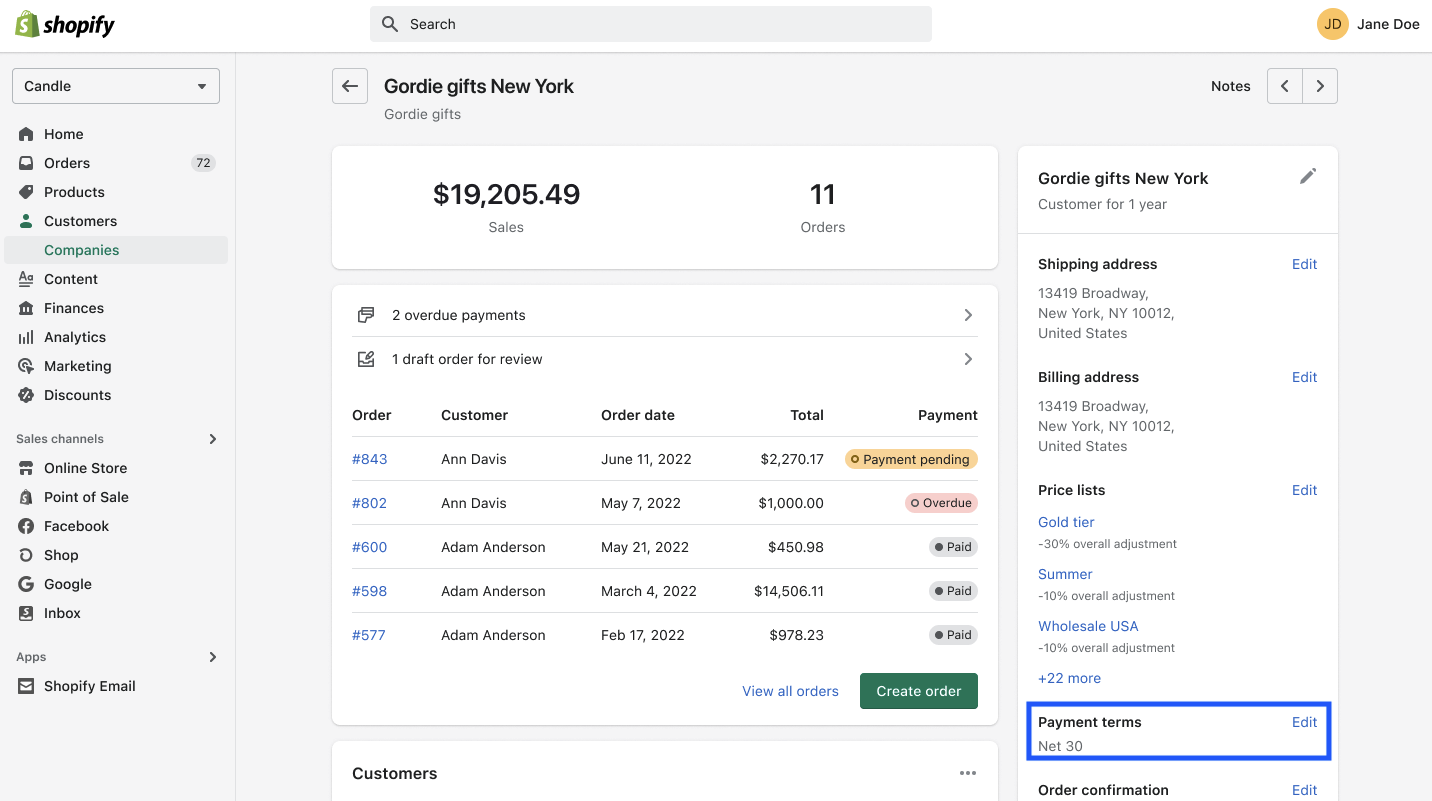
7. Enable mobile ordering
Not all business customers make purchases via their desktop. By 2024, experts predict that 292 million people will own a mobile device—and that 187.5 million of them will make purchases from their smartphones.
An increasing number of B2B buyers order products on the go—especially if they’re encouraged to order quickly by redeeming a time-sensitive discount.
Close the sale by enabling B2B mobile commerce features on your storefront, such as:
-
Made-for-mobile design. From finger-friendly buttons to easy search filters, present information in a way that’s easy to understand on smaller mobile screens.
-
Mobile payment options. If B2B customers do want to pay upfront for their purchases, accept mobile payment methods that store their company credit card, such as Apple Pay or Google Pay.
-
Easily accessible mobile support. Encourage online B2B customers to reach out if they need help. Live chat, for example, can put them in touch with a B2B salesperson at the click of the button, so they can get answers on the go.
Perfect these elements of your online storefront and convert the 90% of B2B buyers who’d be more inclined to repurchase from a business.
8. Offer low first-order minimums
Wholesale customers pay less for products because they purchase in bulk. However, committing to a $500+ order from a new retailer is a big risk for any B2B customer. They need to feel confident they’ll make a return on such a big investment.
Evaluate whether you can offer low minimum order quantities (MOQ) and minimum order values (MOV) for first-time buyers. If your typical MOQ is 50 units and your MOV is $5,000, for example, lowering that to 50 units and $2,500 spend opens the door for smaller businesses to purchase products from your wholesale channel.
If you set lower MOQ and MOV for first-time customers only, you’re not sacrificing profit margins by selling wholesale in lower quantities either. The first order only qualifies for the deal, which gives them plenty of time to gather first-hand experience selling your products. Only then will B2B customers buy into higher order minimums.
9. Build an online portal to make reordering simple
Not all B2B sales have to come from new buyers. By prioritizing relationships with existing business customers, loyalty becomes the default. You’ll earn more revenue from each wholesale customer—without constantly needing to fill your B2B sales pipeline.
Scale retention with an online portal. Data from Statista shows B2B buyers want the ability to order customized products, browse availability, track orders, and find and select products easily—all of which are possible with Shopify.
Use Shopify to build an online customer portal that allows B2B customers to:
-
Invite their co-workers to their company profile. With the right permissions (such as “ordering only”), B2B buyers can ease the hurdle of getting sign-off from multiple people in the buying process.
-
View their order history. Buyers can download invoices, set their tax ID, and list tax exemptions—all without drawing resources away from your sales team to supply them one by one.
-
Shop similar products. Cross-selling and upselling are typically reserved for DTC sales. Offer those same sales experiences to B2B customers with Shopify apps. You’ll increase average order value and create a stronger attachment to your brand, both of which naturally encourage retention.
The real opportunity is combining Shopify’s existing power as an intuitive ecomm solution with the added functionality needed to serve B2B, all in one streamlined solution.”
—Andy Knox, general manager at Van Compass
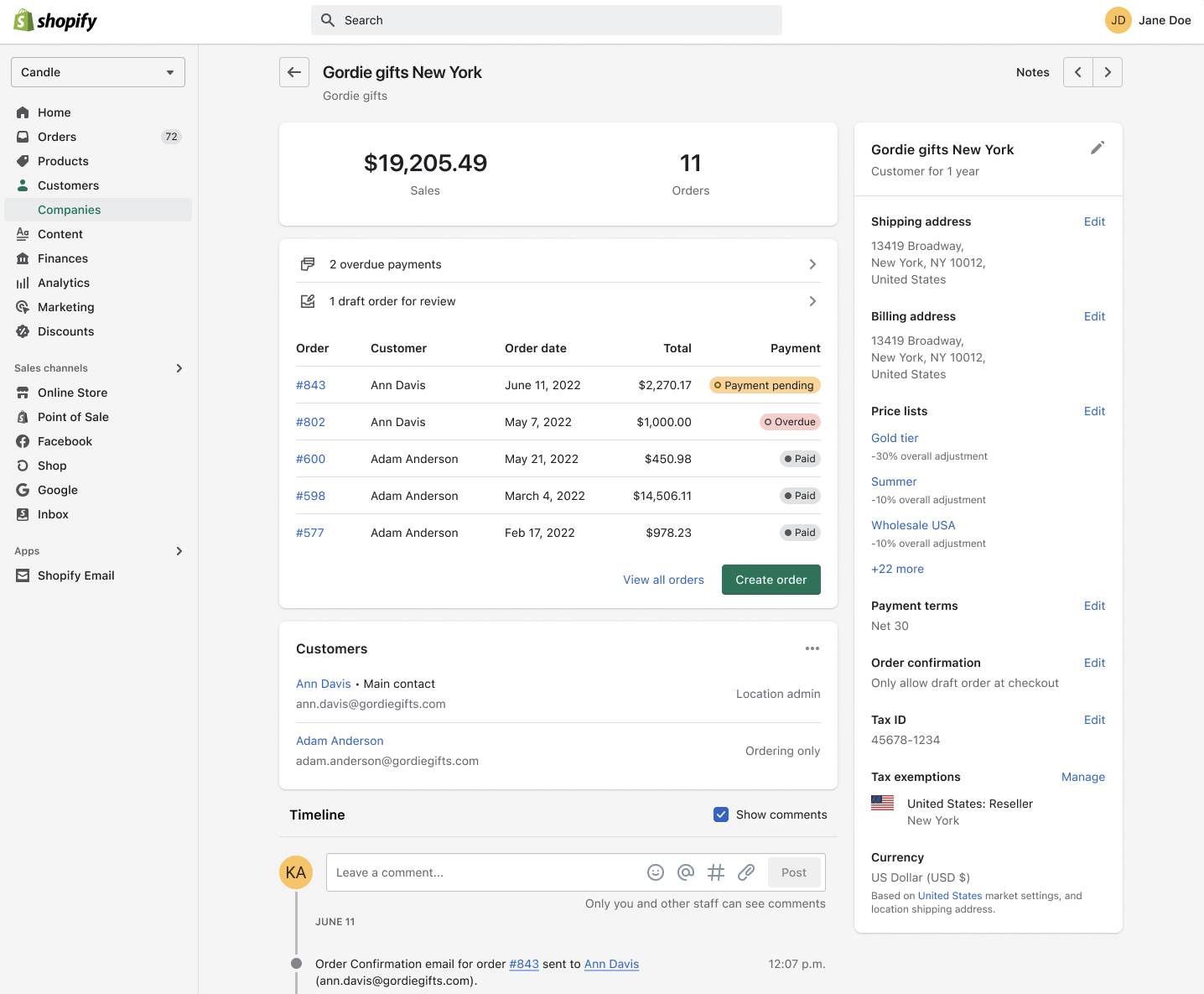
10. Automate the B2B sales process
The B2B sales cycle can be time consuming. Buyers average one to six months between defining a problem to paying for a solution. Prevent that from costing your business thousands in sales representative salaries by automating as much of the process as possible.
Laird Superfood took this approach when managing wholesale orders. Although it accepted DTC orders through an online store, B2B orders could only be accepted via phone or email. As a result, phones in its office were ringing off the hook, and sales representatives were overwhelmed with the sheer amount of administrative work involved in converting customers.
“It was a really labor intensive and time consuming process,” says CEO Paul Hodge. “We needed to switch. We needed a robust platform that offers an automated wholesale portal customers can access anytime they like.”
Laird Superfood switched to Shopify to create a wholesale portal that streamlined and automated its B2B sales process. A password-protected online portal hid custom or negotiated pricing for certain business customers. It meant B2B customers could make orders on their own accord—no sales rep included.
“Being able to automate the wholesale process changes how we build our team. It prevents us from missing 2 a.m. orders and keeps our customers from having to wait to place an order until we’re in the office. It just solves so many problems.”
—Luam Pham, CMO of Laird Superfood
The pivot has paid dividends. Paul Hodge says the wholesale portal saves the equivalent of one employee each year (assuming a salary of $50,000 to $60,000.) These types of B2B sales also account for 75% of the brand’s overall revenue, compared to just 25% pre-Shopify.
Replicate a similar strategy for your business with enterprise resource planning (ERP) tools. Shopify integrates with apps like NetSuite, Acumatica, and Brightpearl. Remove manual entry—and therefore, improve data accuracy—with native integrations that pull data in real time, so you can view your business’s most important metrics in one place.
How Shopify can help scale B2B sales
Business-to-business sales isn’t an easy task. The buying journey for business customers is lengthier. The sales techniques your team is using to convert B2C customers won’t fly when businesses demand high ROI on the products they buy online.
Use Shopify’s B2B ecommerce platform to operate DTC and B2B storefronts from one ecommerce back end. Access features like:
-
Customized payment terms and B2B checkout
-
Company profiles with varied permission levels to encourage repeat B2B sales
-
Discounted wholesale price lists to entice new customers to purchase
-
Customer relationship management (CRM) system and ERP software integrations
-
Automatic payment reminders for B2B customers on net terms, without setting a mental reminder to follow up
-
“B2B on Shopify allows us to leverage technology to streamline and automate our wholesale processes, so we can maintain a high level of focus on retail consumers.” —Andy Knox, Van Compass
Convert more B2B sales with your password-protected storefront, powered from the same ecommerce platform your DTC store is built on. Need help making the transition? Shopify has a network of award-winning Agency Partners and a wealth of B2B sales experience to assist you in building a profitable B2B ecommerce channel.
Read more
- B2B Ecommerce: Everything You Need to Know to Get Started
- B2B Ecommerce: Why Taking Your B2B Business Online is a Smart Strategy to Scale
- 12 B2B Ecommerce Trends To Shape Your Business in 2023
- What Is Wholesale B2B and How To Sell To Customers in 2023
- What Are B2B Payments? Methods & Processing Systems
- B2B Marketplaces: What They Are, How to Succeed, and 8 Marketplaces to Consider
- Find the perfect domain name


